
The fourth USS Baltimore (C-3) was a United States Navy cruiser, the fifth protected cruiser to be built by an American yard. Like the previous one, Charleston, the design was commissioned from the British company of W. Armstrong, Mitchell, and Company of Newcastle. Baltimore was an all-around improvement on Charleston, somewhat larger with more guns, thicker armor, and better machinery.

The first USS Minneapolis (C-13/CA-17) was a United States Navy Columbia-class protected cruiser. She was named for the city of Minneapolis, Minnesota.

USS Marion was a sloop-of-war of the third rate in the Union Navy during the American Civil War launched at the Boston Navy Yard on 24 April 1839. On 10 November 1839, she departed Boston on her first cruise, to Brazil. Sunk when heaved down in the harbor at Rio de Janeiro early in 1842, she was raised and sailed back to Boston, arriving in May. She then set sail for the Caribbean, returning in May 1843. For the next few years, she remained in ordinary at Boston and then cruised off the West Coast of Africa and in the Mediterranean until 1848. She captured the Casket, a slaver, near Cabinda on 2 August 1846. After a tour in the East Indies from 1850–52, she resumed operations with the African Squadron from 1853–55 and 1858-60, capturing three more slaving ships: Brothers off Mayumba on 8 September 1858 and Orion and Ardennes in late April 1859 off the coast of Kongo. 1856-57 was spent in ordinary at Norfolk.

Henry "Harry" Clay Taylor was a rear admiral in the United States Navy who served in the American Civil War and the Spanish–American War. He also served as Chief of the Bureau of Navigation and President of the Naval War College.
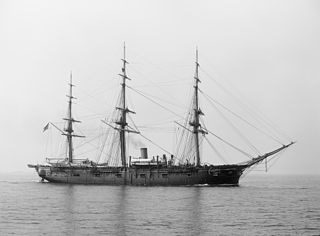
The first USS Lancaster was a screw sloop-of-war in the United States Navy during the American Civil War through the Spanish–American War.

USS Saranac was a sloop-of-war of the United States Navy. The ship laid down in 1847 during the Mexican–American War; however, by the time she completed sea trials, the war was over. She was commissioned in 1850 and saw service protecting American interests in the Atlantic Ocean as well as the Pacific Ocean.
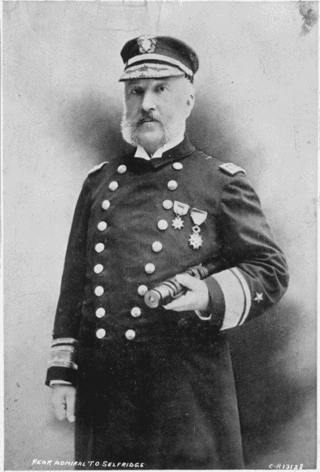
Thomas Oliver Selfridge Jr., son of Rear Admiral Thomas O. Selfridge, was an officer in the United States Navy.

Admiral Samuel Shelburne Robison CB, USN was a United States Navy officer whose service extended from the 1890s through the early 1930s. He held several major commands during World War I, and from 1928 to 1931 served as Superintendent of the United States Naval Academy. In 1933, Admiral Robison also founded a Naval Preparatory Academy in Pine Beach, New Jersey called Admiral Farragut Academy.
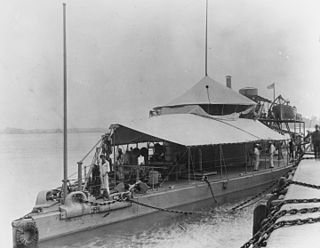
USS Ajax, originally named USS Manayunk after a town in Pennsylvania, was a single-turreted Canonicus-class monitor built for the Union Navy during the American Civil War. Completed after the end of the war, Ajax was laid up until 1871, although she received her new name in 1869. The ship was briefly activated in 1871, before a much longer commission began in 1874–1875. She was assigned to the North Atlantic Squadron during this time. Ajax was again placed in reserve in 1891. The ship was on militia duty when the Spanish–American War began and she was recommissioned in 1898, to defend Baltimore, Maryland, although she was decommissioned later in the year before the necessary refit could be completed. Ajax was sold for scrap in 1899.

The first USS Palos was a 4th rate iron screw tug in the United States Navy during the late 19th century. She was named for Palos de la Frontera in Spain, the place where Christopher Columbus started the first voyage to America.
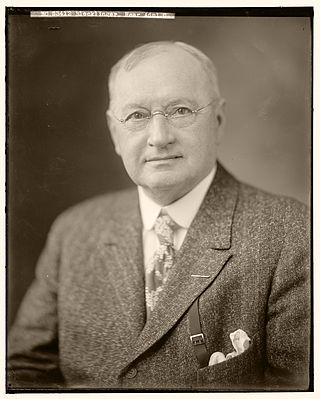
Gottfried Blocklinger (1847-1930) was a Rear-admiral in the United States Navy.

Franklin Jeremiah Drake was a Rear Admiral in the United States Navy. He fought in the American Civil War and the United States expedition to Korea.
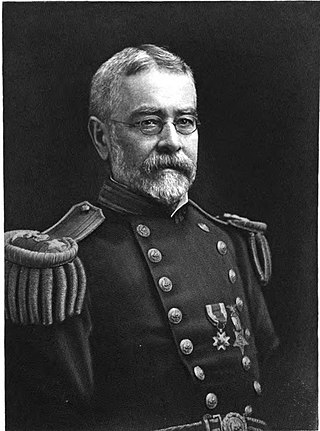
Yates Stirling was a rear admiral in the United States Navy.

Joseph P. Fyffe was a rear admiral in the United States Navy. He saw service in both the Mexican War and the American Civil War.
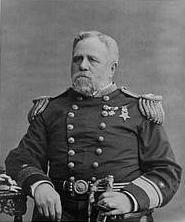
Rear Admiral Charles Carroll Carpenter was an officer in the United States Navy. He participated in the African Slave Trade Patrol, fought in the American Civil War, served as commander of the Asiatic Squadron, and was recalled to duty briefly during the Spanish–American War.

Rear Admiral Frederick W. Rodgers was an officer in the United States Navy. He fought in the American Civil War and rose to be the last commander of the Asiatic Squadron. He was a grandson of U.S. Navy Commodore Matthew C. Perry.
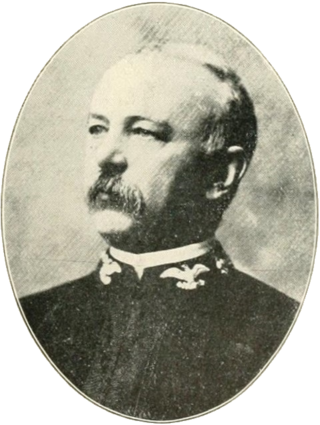
Rear Admiral Philip Henry Cooper was an officer in the United States Navy. He fought in the American Civil War and served as Superintendent of the United States Naval Academy and as commander-in-chief of the United States Asiatic Fleet.
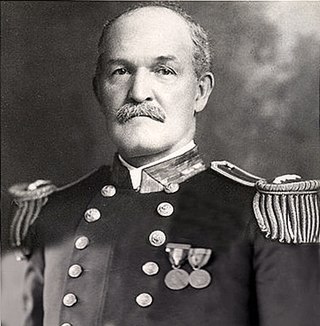
Rear Admiral Joseph Ballard Murdock, sometimes spelled Murdoch, was an officer in the United States Navy. He fought in the Spanish–American War, was Commander-in-Chief of the United States Asiatic Fleet, and came out of retirement to serve during World War I. In retirement, he was a member of the New Hampshire House of Representatives. He also was an author of books on naval and scientific subjects.

Rear Admiral Newton Eliphalet Mason was a United States Navy officer. His career included combat in the Spanish–American War and service during World War I, significant experience in ordnance duty, and a very long tour as Chief of the Bureau of Ordnance.
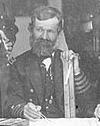
Rear Admiral George H. Cooper was an officer in the United States Navy. During his long naval career, he served on the African Slave Trade Patrol, and fought in the Second Seminole War, the Mexican War, the American Civil War, and the Korean Expedition, and rose to command of the North Atlantic Squadron.




















